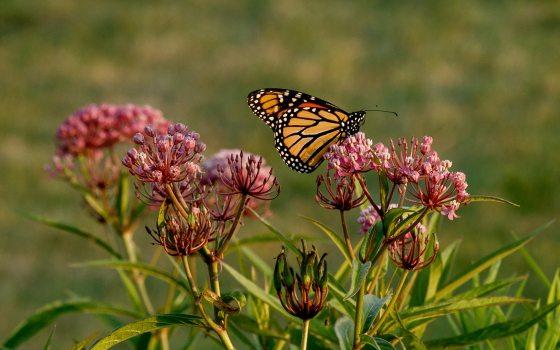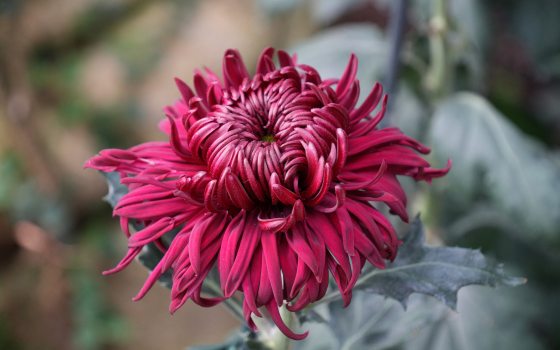A familiar and well-loved part of our natural world, butterflies are not just pretty insects of our gardens; they play a much larger role in our ecosystems than many realize. Butterflies—recognizable by their bright, erect wings and long clubbed antennae—are part of the larger order Lepidoptera, which also includes moths (mostly night-fliers with furry antennae) and skippers (erratic fliers with angled wings). Through our new lepidopteran monitoring initiative, Longwood’s Land Stewardship and Ecology team is working with dedicated volunteers to understand which butterflies, moths, and skippers are frequenting our Meadow Garden, and what that says about not only the Meadow Garden, but the ecosystem of our greater landscape. Our Ecological Science Volunteer Team observes local lepidopterans throughout the warmer months of the year as part of our Ecological Baseline Study—a comprehensive initiative that will help us to track, understand, and manage long-term change in our ecosystem here at Longwood.
The name of the order Lepidoptera comes from the Greek, meaning “scaly-winged”, referring to the microscopic, dust-like scales that cover their wings. Combined, there are more than 180,000 species within the order Lepidoptera across the globe. Beginning as eggs laid on vegetation, lepidopterans go through three more life stages: larva (or caterpillar), pupa (or chrysalis), and adult (or imago).
Alongside our native bees and hoverflies, lepidopterans play a very important role in the Meadow Garden by pollinating hundreds of blooming plant species such as mountain mints (Pycnanthemum muticum, Pycnanthemum tenuifolium), wild bergamot (Monarda fistulosa), milkweeds (Asclepias syriaca, Asclepias tuberosa, Asclepias incarnata), native thistles (Cirsium discolor, Cirsium horridulum), coneflowers (Echinacea purpurea, Rudbeckia laciniata), and of course our many species of fall-blooming goldenrod (Solidago spp.) and asters (Symphyotrichum spp.). As they visit flowers to drink nectar, pollen sticks to their legs and bodies and then rubs off at the next flower they visit, fertilizing the flower and beginning the essential process of seed production that ensures the plant’s next generation.
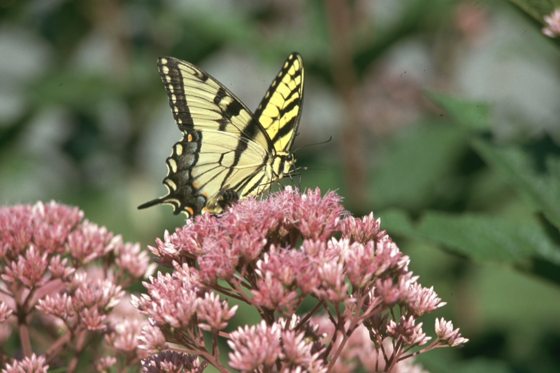
While an Eastern tiger swallowtail (Papilio glaucus) enjoys the nectar from a Joe-Pye-weed (Eutrochium sp.), pollen sticks to its body. When it lands on the next Joe-Pye-weed flower, it will aid in pollination.
Not only do lepidopterans serve as essential pollinators in their winged adult phase, but as caterpillars they are an important food source for other animals. Those protein-packed caterpillars are rich in healthy fats that are essential food for young birds of most species, even those that eat mostly seeds as adults. These young birds can eat thousands of caterpillars before they grow big enough to leave the nest and seek out other food sources, so it is important to have an abundance of caterpillars—and therefore, an abundance of plants for herbivorous caterpillars to eat. Where lepidopteran numbers decline, it can be expected that bird populations will suffer as well.
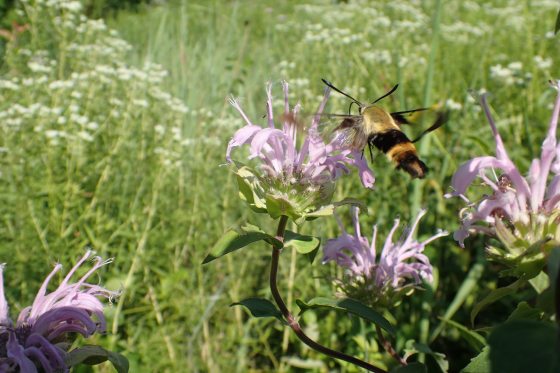
A snowberry clearwing moth (Hemaris diffinis) feeding on wild bergamot (Monarda fistulosa). A species of dayflying "hummingbird moth", this species is actually more of a bee-mimic than a hummingbird-mimic due to its yellow and black coloration. Photo by Collin McCallum-Cook.
Lepidopterans are also uniquely useful as bioindicators—species that can tell us about the health of an ecosystem—because they are sensitive to changes in temperature, humidity, light, and the plant species they depend on for food, all of which may be altered by changes people make to environments. Monarch butterflies, which were recently listed as endangered by the International Union for Conservation of Nature, are an example of this “canary in the coalmine” capability. Habitats supporting monarchs along their great migration between Central America near Mexico City and North America have been fragmented and transformed to other uses, making milkweeds, which are the only host plants for their caterpillars to feed on, increasingly scarce. Planting native milkweeds is an important way to support monarch butterflies across their migratory route.
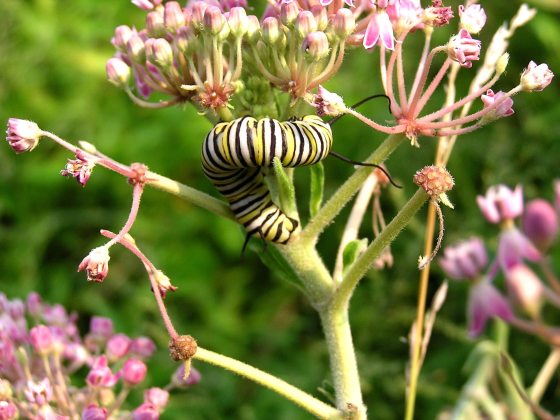
A monarch (Danaus plexippus) caterpillar gains the energy it needs to metamorphize into a butterfly by making a meal of swamp milkweed (Asclepias incarnata). This showy pink milkweed is a good choice for a moist, sunny spot. Photo by Don Whiteley.
To collect data for our lepidopteran monitoring initiative and Ecological Baseline Study, our team must conduct their research during precise conditions. Lepidopterans rest in hidden spots until the specific weather conditions that are best for them to fly. Temperatures must be warm but not too hot, somewhere between 65 and 95 degrees Fahrenheit. Wind speeds must be less than ten miles per hour. On top of all that, it must also be sunny. When all these conditions are met, our team heads out into the Meadow Garden to monitor three sections of path, each measuring 500 meters long. The team slowly and carefully walks along the path and records each lepidopteran species and what they are observed doing—whether they are flying, resting, nectaring, or laying eggs. If the insect happens to be on a plant, the team also notes which plant species as well. All of this is done using custom-built data collection tools that we have created to record location and details of each observation.
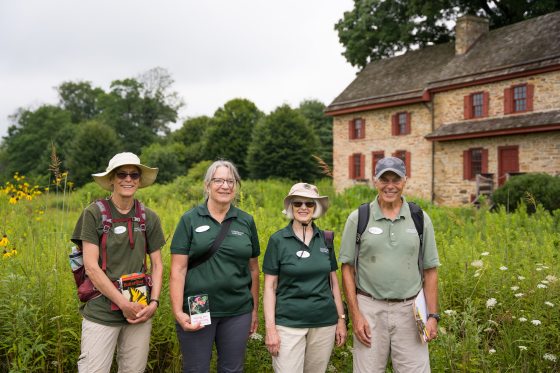
Knowing what lepidopteran species are present, and which plants they use, will help to inform our management of the Meadow Garden. As we repeat this sampling each summer, we will be able to track how our Meadow Garden populations are doing over time.
This initiative is just one of our community science programs that engage people with the natural world and promote community understanding of the importance of conservation and management. You too can also contribute to science using the iNaturalist app the next time you visit! If you see any butterflies, moths, or skippers, snap a photo and upload it to iNaturalist, and it will automatically become part of the Longwood Wildlife Project.
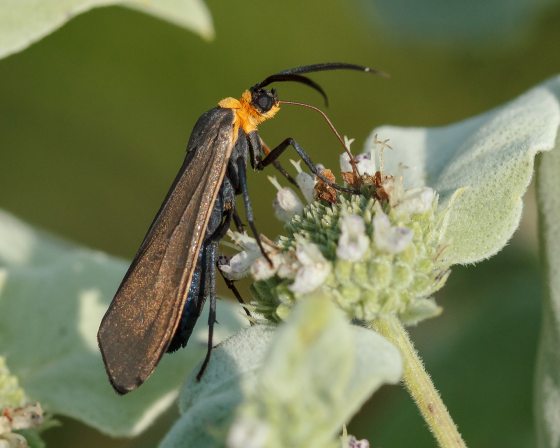
A yellow-collared scape moth (Cisseps fulvicollis) nectaring on blunt mountain-mint (Pycnanthemum muticum). Mountain-mints (Pycnanthemum spp.) and coneflowers (Rudbeckia spp.) are pollinator favorites. Photo by Tom Potterfield.


An Eastern tiger swallowtail visits a cup-plant (Silphium perfoliatum) in the Meadow Garden. Photo by William Hill.
Thankfully, you don’t need an 86-acre Meadow Garden to help our winged friends and provide suitable habitat. By planting pollinator-friendly species in your own yard, you can encourage them to stop by to nectar or even to lay eggs for the next generation. In addition to goldenrods and mountain mints, helpful herbaceous plants include wild-indigo (Baptisia tinctoria), Joe-Pye-weed (Eutrochium spp.), wild bergamot (Monarda fistulosa), blazing-star (Liatris spicata), New England aster (Symphyotrichum novae-angliae), and New York ironweed (Vernonia noveboracensis). Shrubs like New Jersey-tea (Ceanothus americanus), bottlebrush buckeye (Aesculus parviflora) and pussy willow (Salix discolor) are also rich sources of pollinator food. Oak trees (Quercus spp.) are extremely helpful to lepidopterans, supporting hundreds of species of caterpillars. When planning your pollinator garden, be sure to include plants that are staggered in their blooming throughout the growing season to ensure that flowers are present all summer long!
